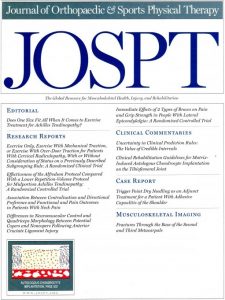Publications

Short-Term Effects of Manual Therapy in Patients After Surgical Fixation of Ankle and/or Hindfoot Fracture: A Randomized Clinical Trial
Authors: Stephanie R. Albin, Shane L. Koppenhaver, Robin Marcus, Lee Dibble, Mark Cornwall, Julie M. Fritz
Affiliations: Regis University, Denver, CO. Baylor University, Waco, TX. University of Utah, Salt Lake City, UT. Northern Arizona University, Flagstaff, AZ, USA
Journal: Journal of Orthopaedic & Sports Physical Therapy - February 2019, Volume 49, Issue 2, Page 1-31 (DOI: 10.2519/jospt.2019.8864)
-
Field & Applications:
- Medical
- Musculoskeletal rehabilitation
- Orthopedics
- Recovery from injury
- Clinical trial
Study Design: Multi-site double blind randomized clinical trial.
Background: Patients with surgical fixation of ankle and/or hindfoot fractures often experience decreased range of motion and loss of function following surgery and post-surgical immobilization, yet there is minimal evidence to guide care for these patients.
Objectives: To assess if manual therapy produces short-term improvements in range of motion, muscle stiffness, gait, and balance for patients undergoing operative fixation of an ankle and/or hindfoot fracture.
Methods: Seventy-two consecutive patients who had undergone an open reduction internal fixation of an ankle and/or hindfoot fracture and were receiving physical therapy consisting of exercise and gait training were randomized to either receive impairment-based manual therapy (MT group) or sham manual therapy consisting of light soft-tissue mobilization and proximal tibiofibular joint mobilizations (CONTROL group). Participants in both groups received 3 treatment sessions over 7 to 10 days and outcomes were assessed immediately post-intervention. Outcomes included ankle joint range of motion, muscles stiffness, gait characteristics, and balance measures. Group by time effects were compared using linear mixed-modeling.
Results: There were no significant differences between the MT and CONTROL groups for motion, gait, or balance outcomes. There was a significant difference from baseline to the final follow-up for resting gastrocnemius muscle stiffness between the MT and CONTROL group [-47.9 N/m (95% CI: -86.1, -9.8), P= .01]. There was no change in muscle stiffness for the MT group between baseline and final follow-up, whereas muscle stiffness increased in the CONTROL group approximately 9%.
A brief course of manual therapy consisting of 3 treatment sessions over 7 to 10 days did not lead to better short term improvement than the application of sham manual therapy for most clinical outcomes in patients after ankle and/or hindfoot fracture who were already being treated with exercise and gait training. Our results, however, suggest that manual therapy might decrease aberrant resting muscle stiffness after ankle and/or hindfoot surgical fixation.
Level of Evidence: Therapy, Level 2.
Results of this randomized controlled trial suggest that 3 sessions of impairment-based manual physical therapy for patients with ORIF for an ankle and/or hindfoot fracture who were already receiving physical therapy consisting of exercise and gait training did not result in greater improvement of motion, gait, or balance compared to therapy consisting of soft tissue mobilization and proximal tibiofibular joint mobilization. The only between-group difference identified was in resting muscle stiffness which increased in the CONTROL group, but not in the MT group. This might suggest that manual therapy may decrease short-term aberrant neuromotor effects after ankle and/or hindfoot surgical fixation. It is possible that this population of patients may benefit from intervening earlier in the post-operative phase or from a greater number of manual therapy treatments.
Key Points: Findings: For patients undergoing an ORIF for an ankle and/or hindfoot fracture, three sessions of impairment-based manual therapy did not result in greater improvements in motion, gait, and balance, compared to a control group receiving soft-tissue mobilization and proximal tibiofibular joint mobilization.
Implications: Manual therapy may decrease short-term aberrant neuromotor effects after ankle and/or hindfoot fracture treated with open reduction internal fixation.
Caution: Due to the short-term and low frequency of the manual therapy utilized in this study, results of this trial regarding the role of manual therapy in the management of patients sustaining hindfoot and/or ankle fractures should be interpreted with caution.


